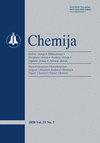Thermodynamic, thermochemical and thermophysical properties of HgBr2
IF 0.4
4区 化学
Q4 CHEMISTRY, MULTIDISCIPLINARY
引用次数: 0
Abstract
For mercury dibromide HgBr2, a promising component of the working mixture of gas-discharge exciplex sources of coherent (lasers) and spontaneous (exciplex lamps) radiation, as well as a promising nonlinear optical crystal for the infrared radiation process, thermodynamic and thermochemical properties in the temperature range 173–512 K were investigated. The established basic thermodynamic (isobaric heat capacity Ср, total entropy S, enthalpy H and Gibbs energy G) and thermochemical (enthalpy ΔHf and Gibbs energy ΔGf of formation) functions of HgBr2 were compared with the known literature data at 298–514 K. The obtained results differed from the literature within 1–2% (for Ср), 0.1–0.2% (for S, H and G) and 0.1–0.6% (for ΔHf and ΔGf). The experimental data, combined with semi-empirical approaches and ab initio calculations taken from the literature, were used to estimate the previously unknown additional thermodynamic and thermophysical properties of HgBr2: isochoric heat capacity CV, Debye temperature θD, volume thermal expansion αV, isothermal compressibility βT (isothermal bulk modulus BT = 1/βT), Grüneisen constant γG, phonon longitudinal vl, transverse vs, average –v velocities and phonon thermal conductivity κ. In the present work, it was found that crystalline mercury dibromide expands strongly upon heating and has a low phonon thermal conductivity.HgBr2的热力学、热化学和热物理性质
二溴化汞HgBr2是相干(激光)和自发(激基复合灯)辐射的气体放电激基复合物源的工作混合物中的一种有前途的组分,也是红外辐射过程中有前途的非线性光学晶体,研究了173–512 K温度范围内的热力学和热化学性质。将HgBr2的基本热力学(等压热容Ср、总熵S、焓H和吉布斯能G)和热化学(形成的焓ΔHf和吉布斯能ΔGf)函数与298–514 K的已知文献数据进行了比较。获得的结果与文献的差异在1–2%(Ср)内,0.1–0.2%(对于S、H和G)和0.1–0.6%(对于ΔHf和ΔGf)。实验数据,结合半经验方法和文献中的从头计算,用于估计HgBr2先前未知的额外热力学和热物理性质:等容热容CV、德拜温度θD、体积热膨胀αV、等温压缩性βT(等温体积模量BT=1/βT),Grüneisen常数γG、声子纵向vl、横向vs、平均–v速度和声子热导率κ。在本工作中,发现结晶二溴化汞在加热时强烈膨胀,并且具有低的声子热导率。
本文章由计算机程序翻译,如有差异,请以英文原文为准。
求助全文
约1分钟内获得全文
求助全文
来源期刊

Chemija
化学-化学综合
CiteScore
1.30
自引率
16.70%
发文量
14
审稿时长
>12 weeks
期刊介绍:
Chemija publishes original research articles and reviews from all branches of modern chemistry, including physical, inorganic, analytical, organic, polymer chemistry, electrochemistry, and multidisciplinary approaches.
 求助内容:
求助内容: 应助结果提醒方式:
应助结果提醒方式:


